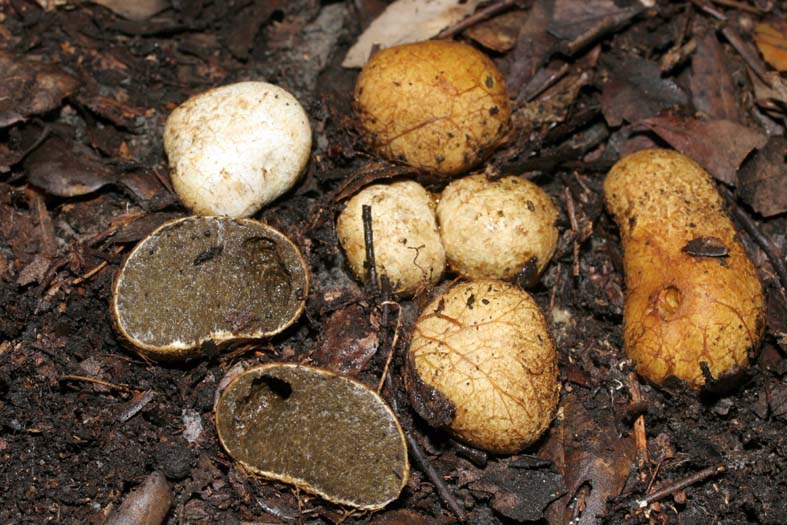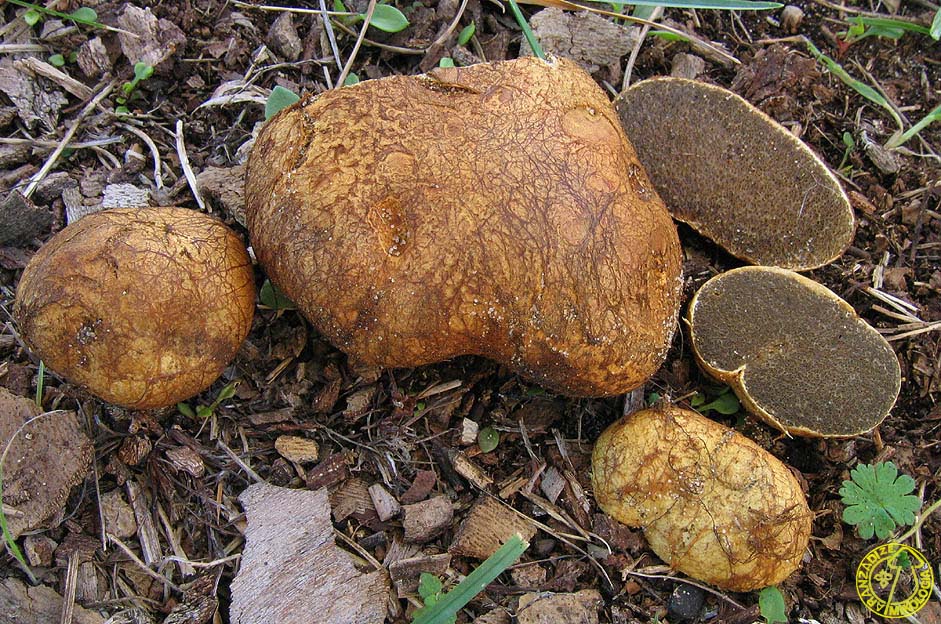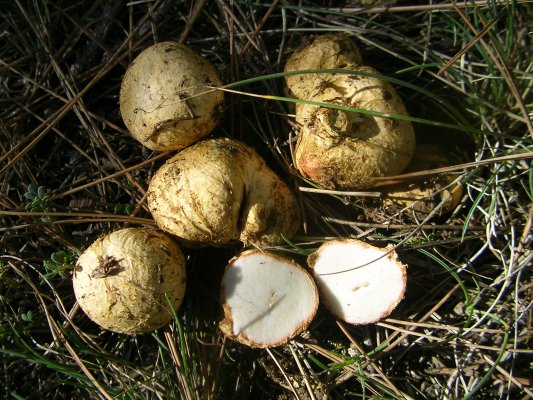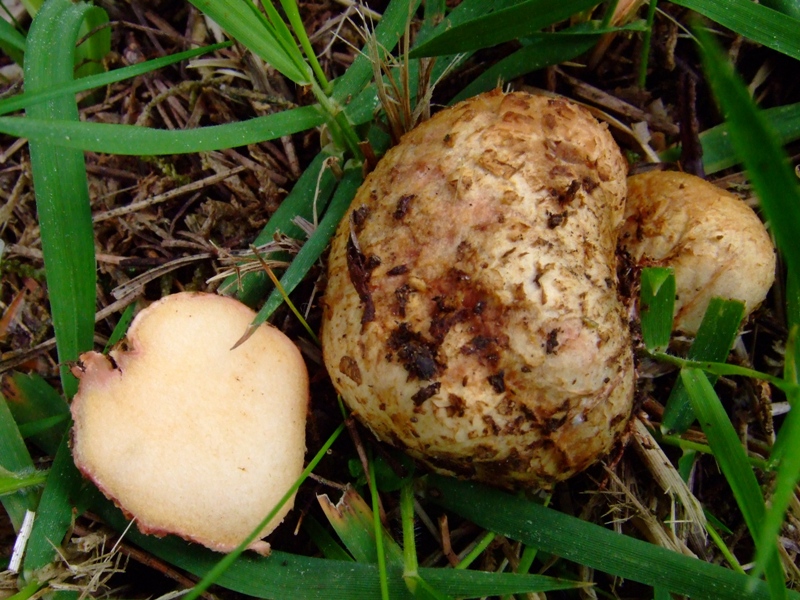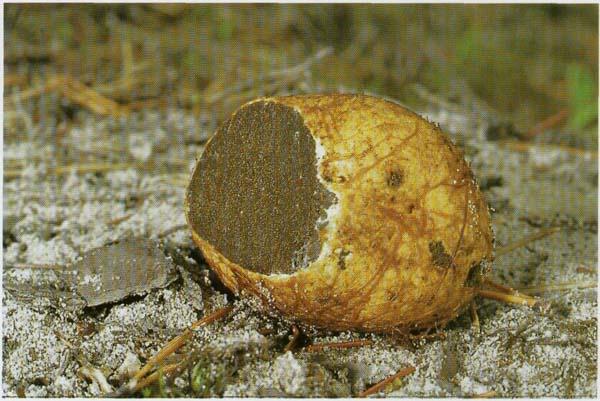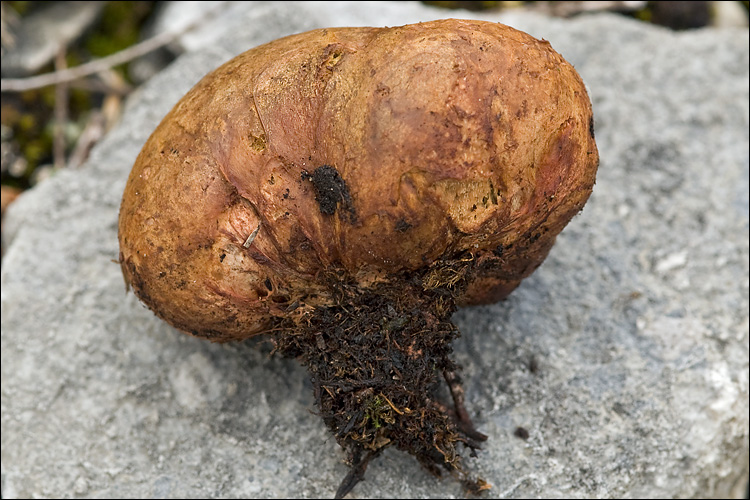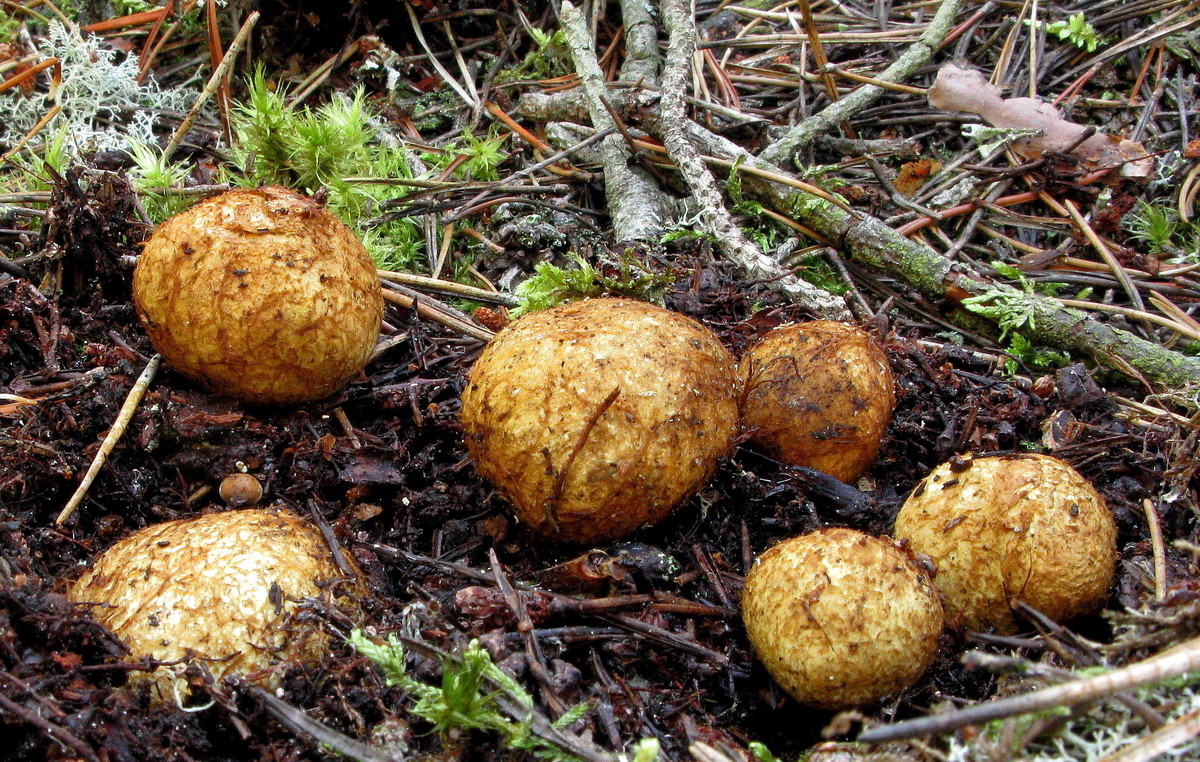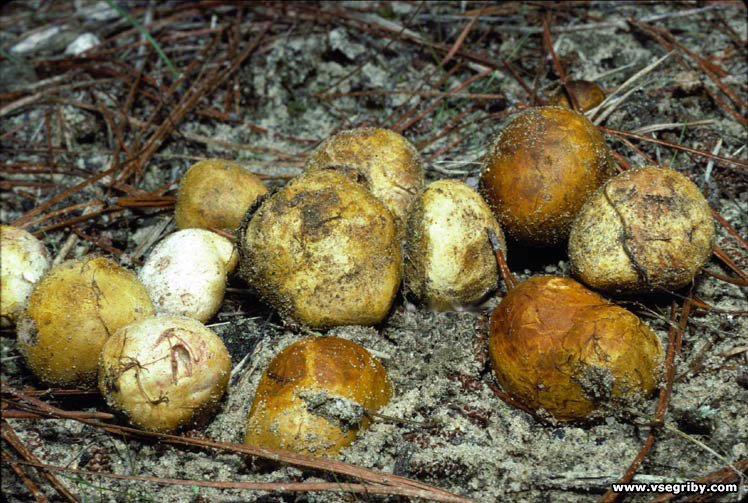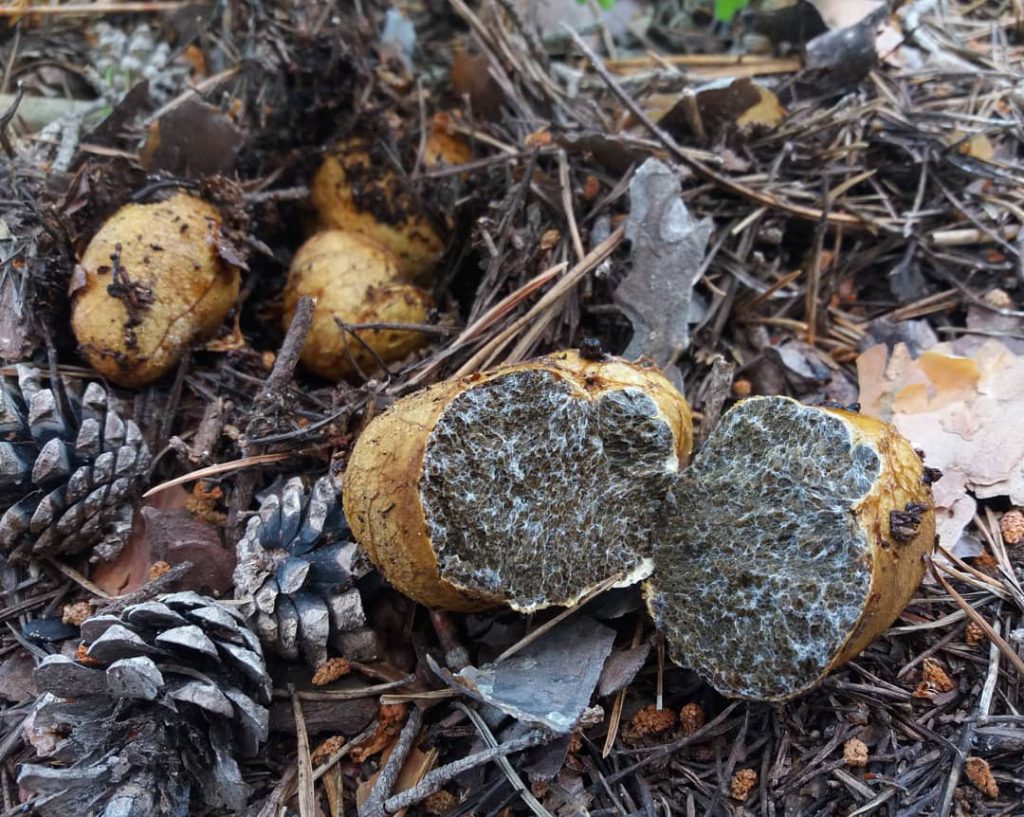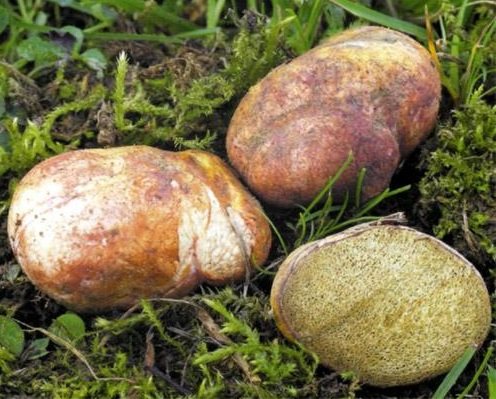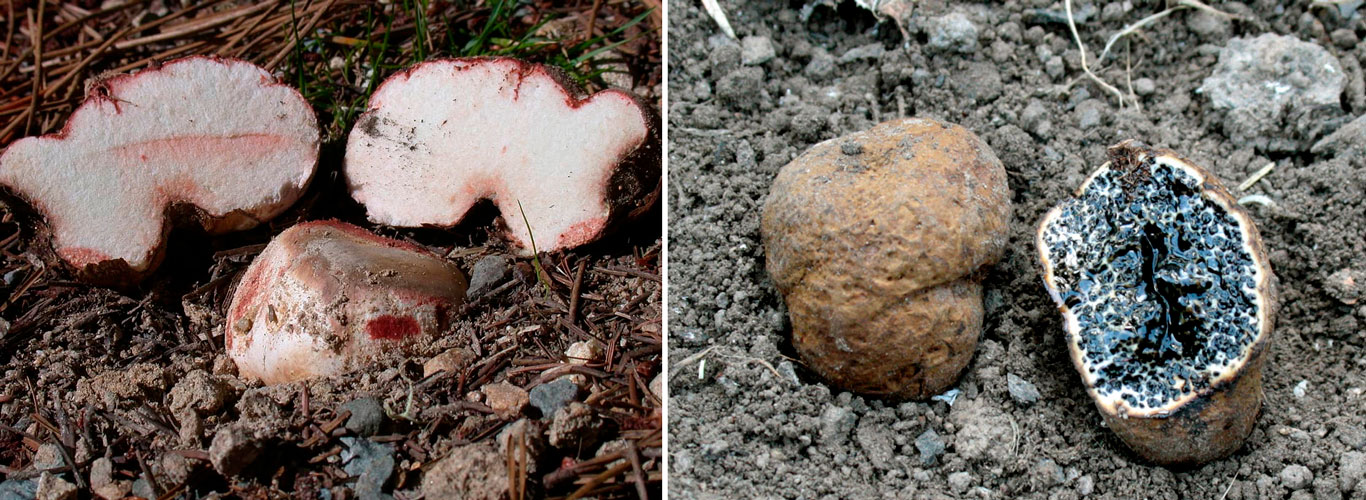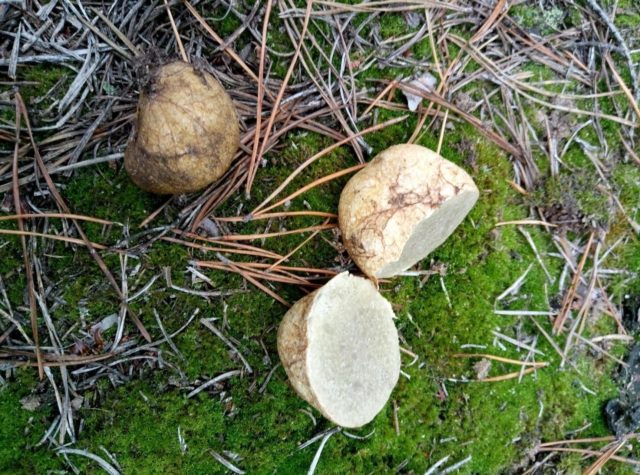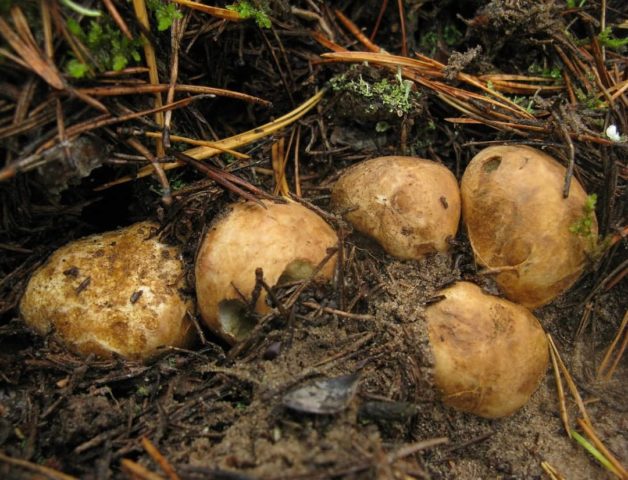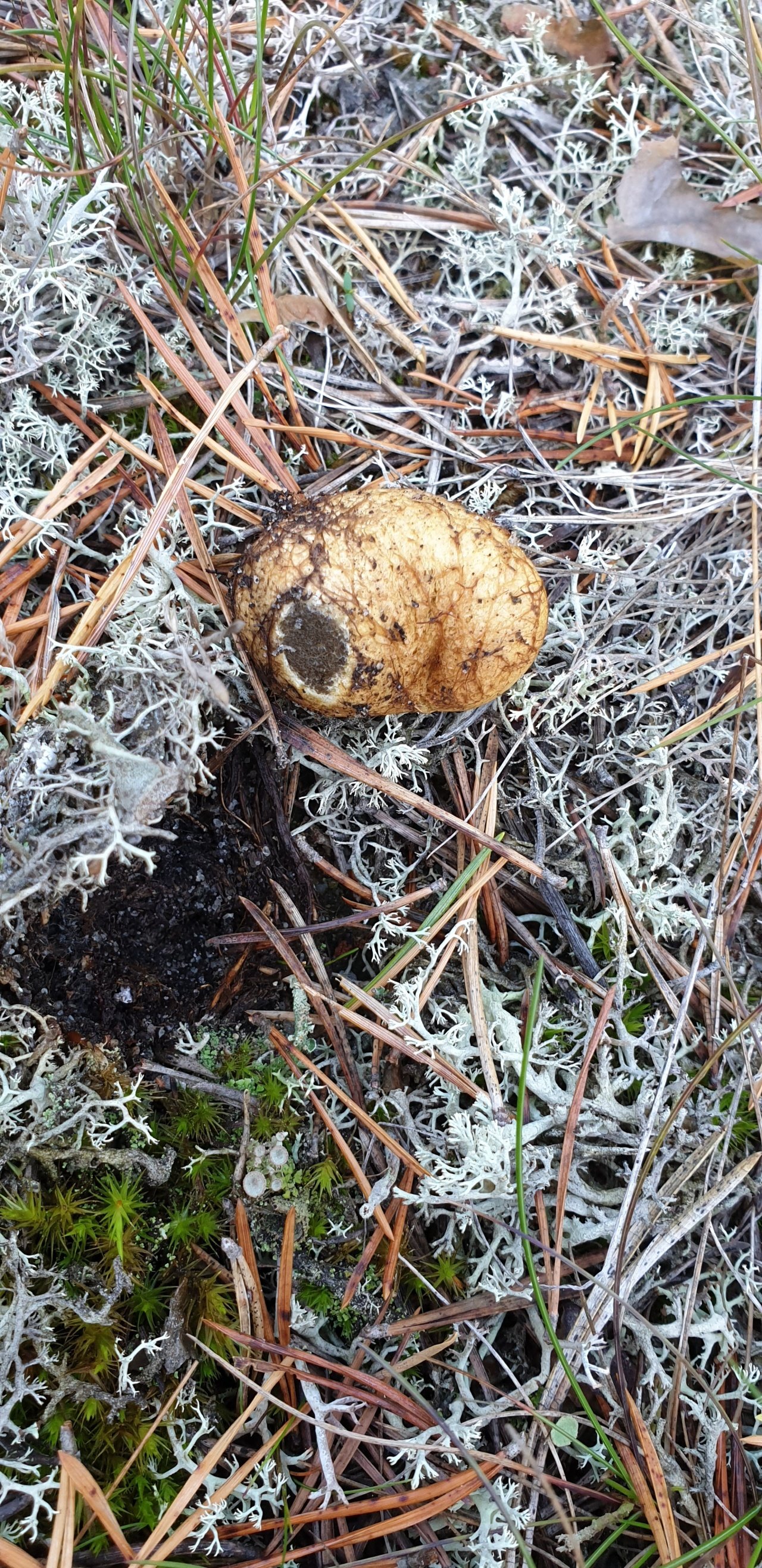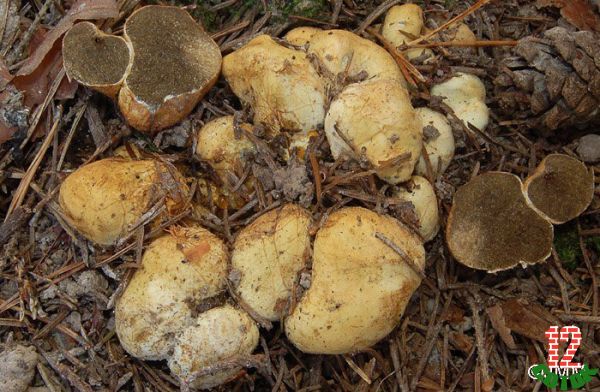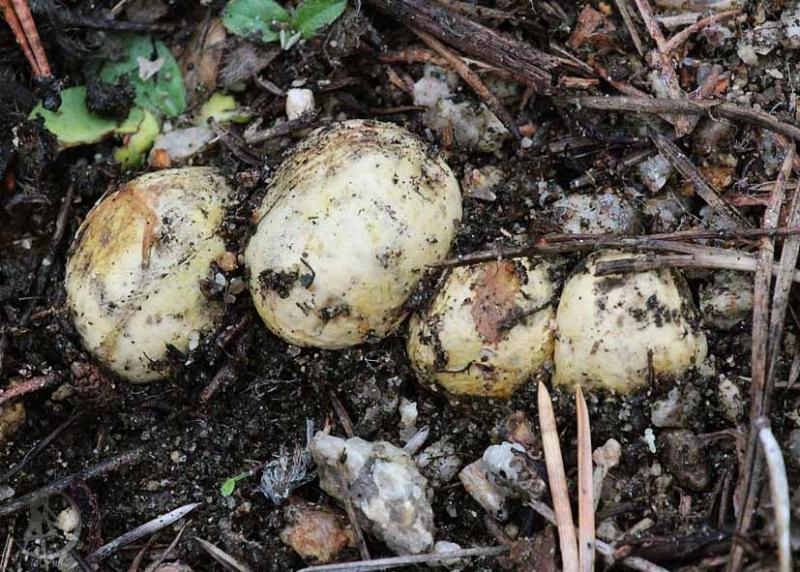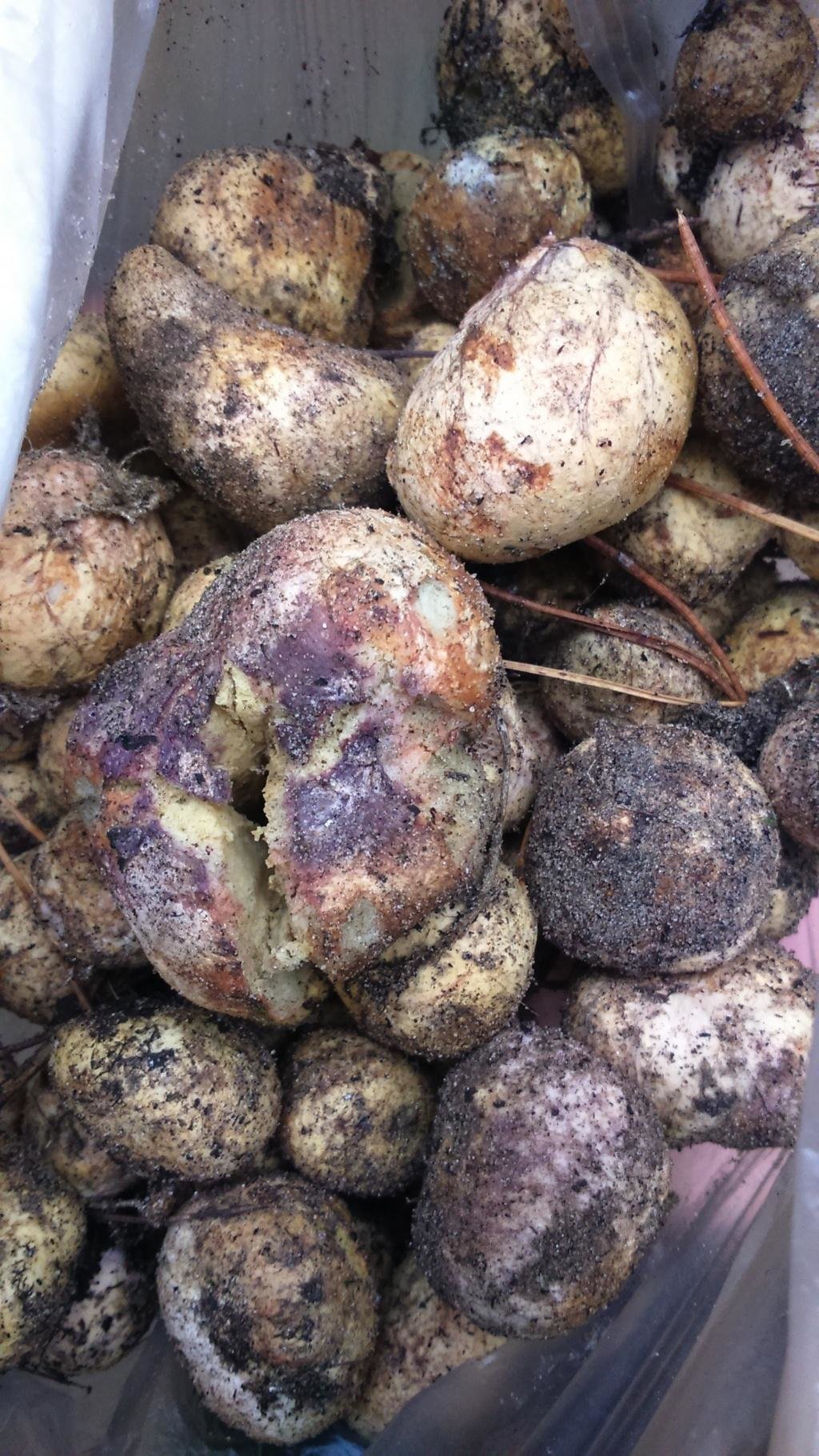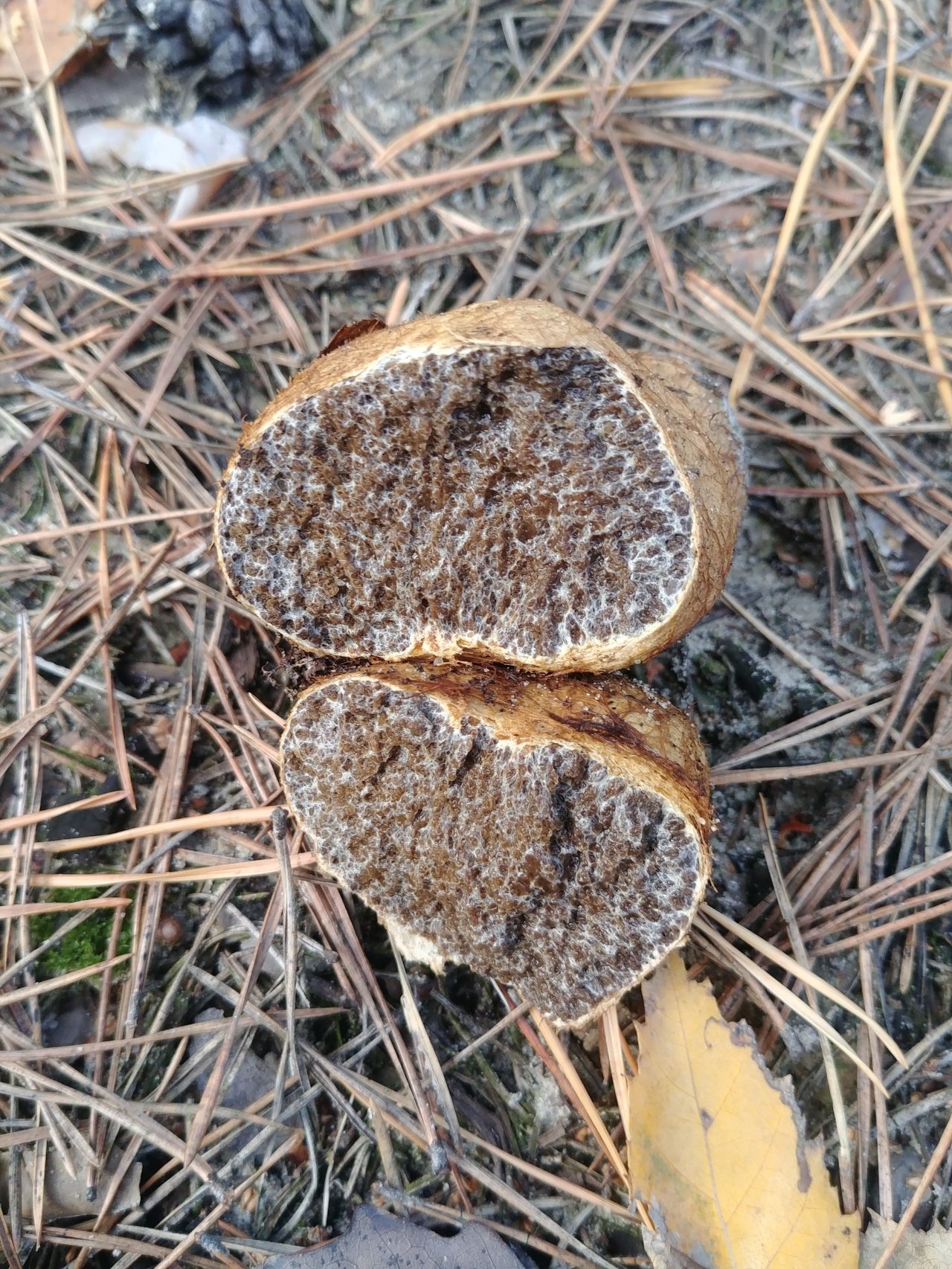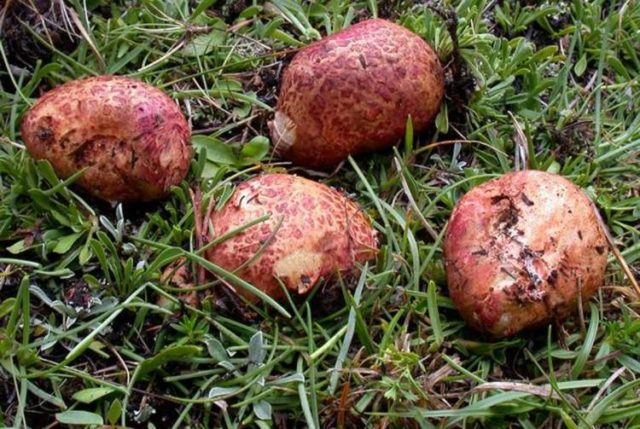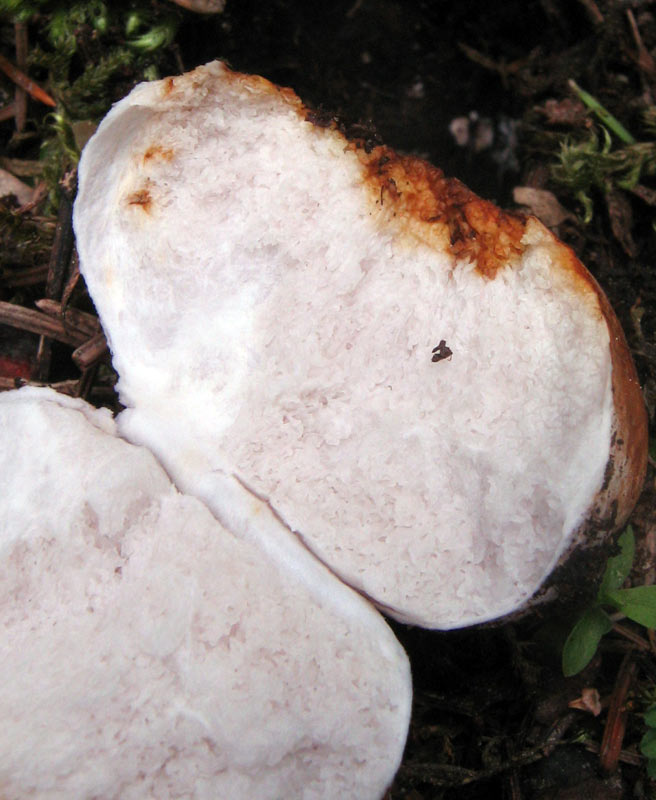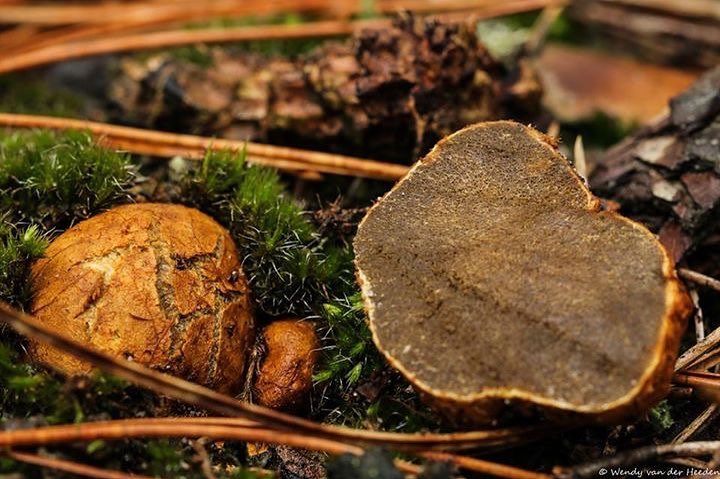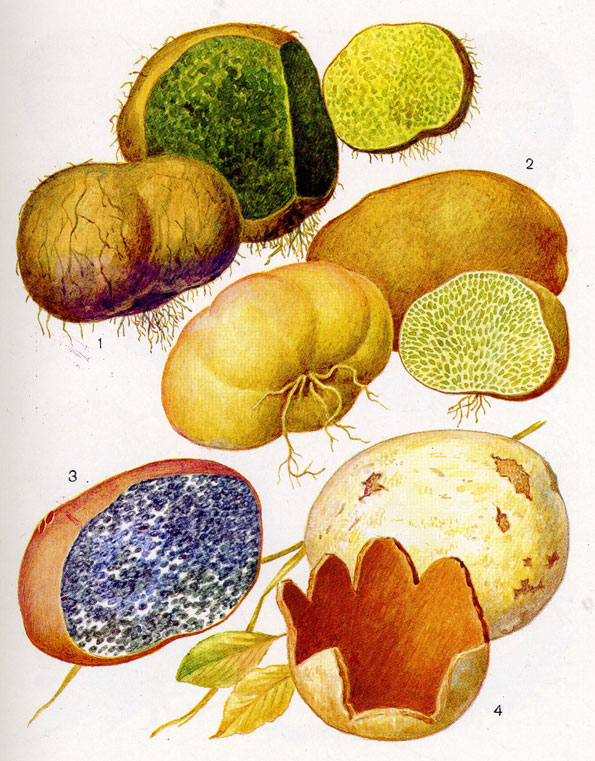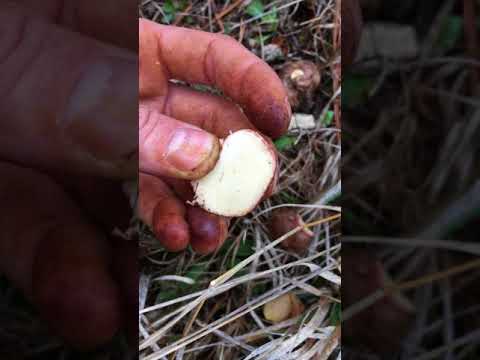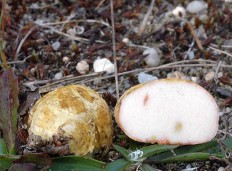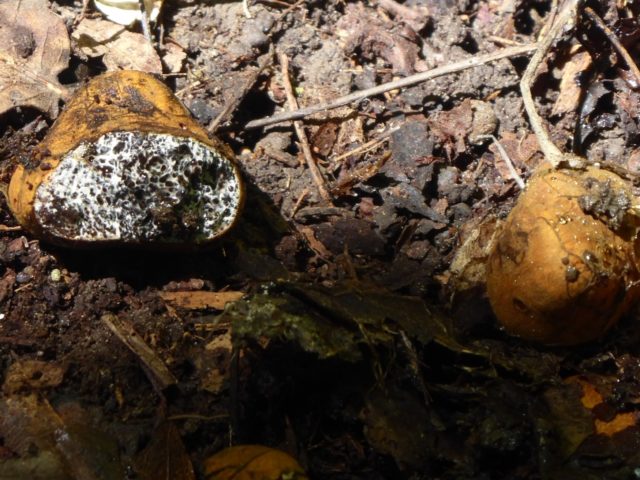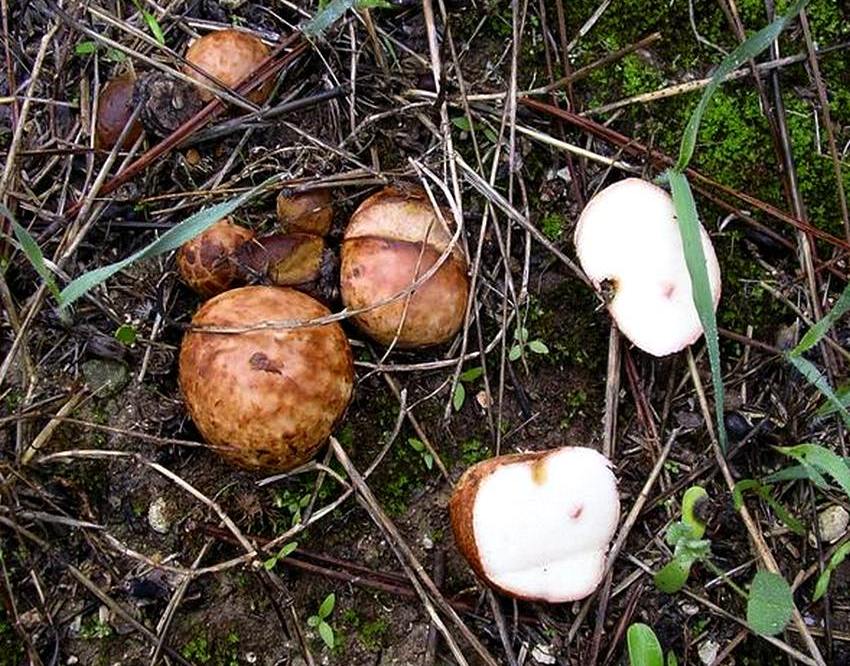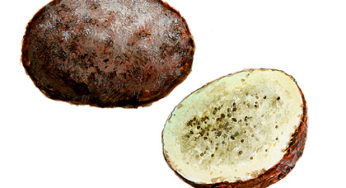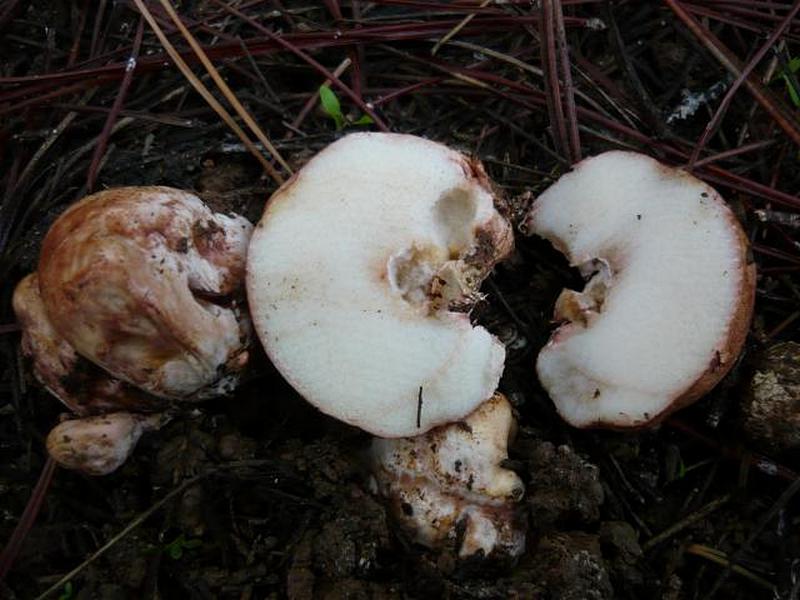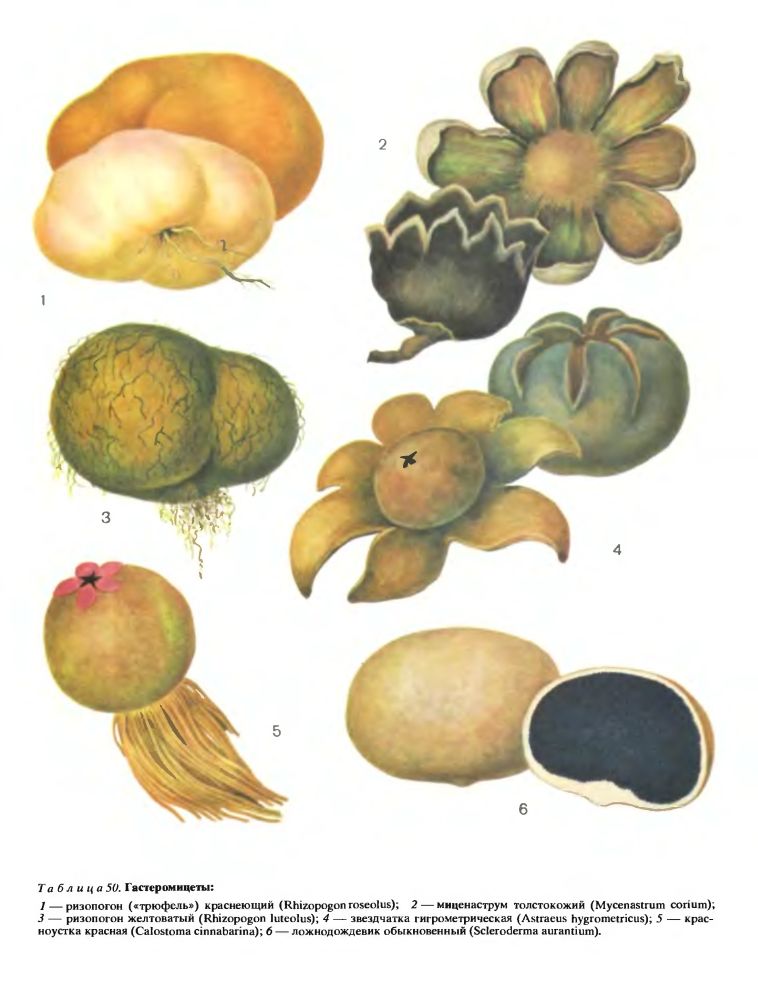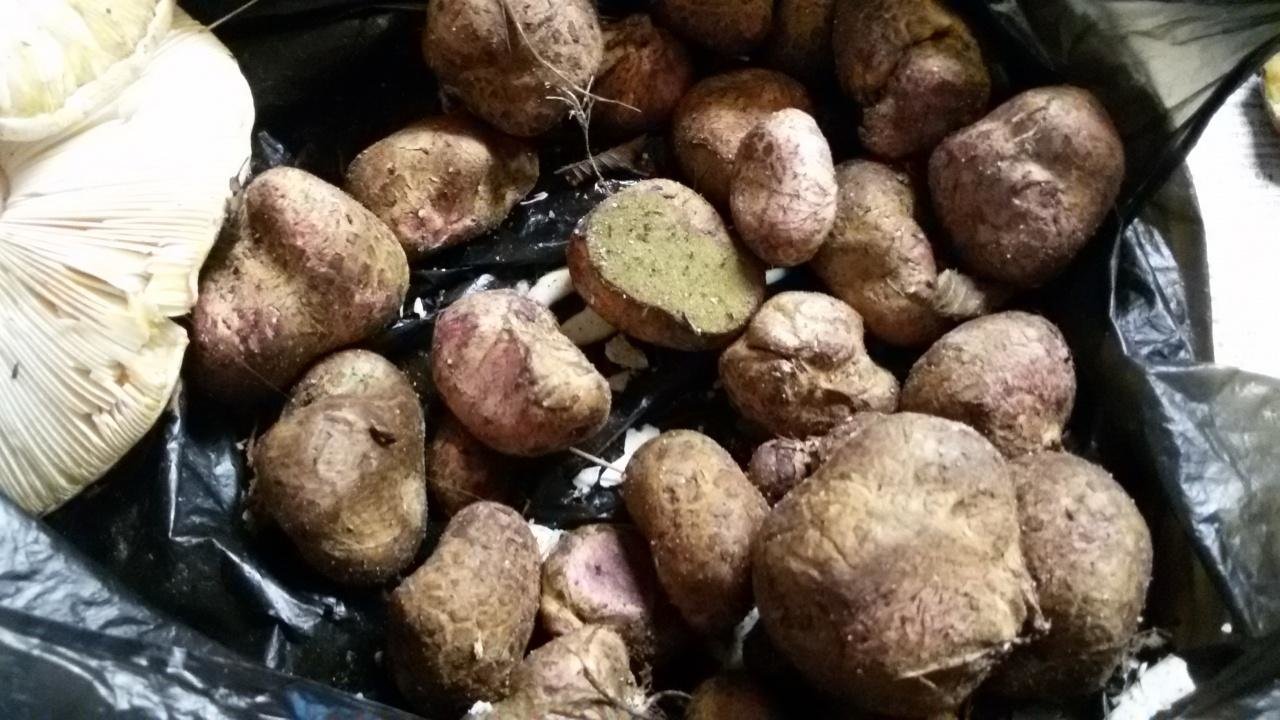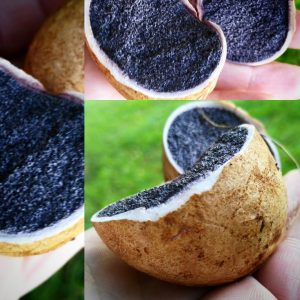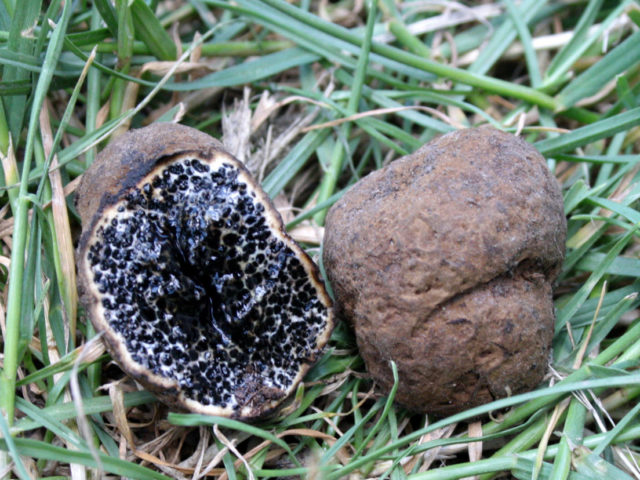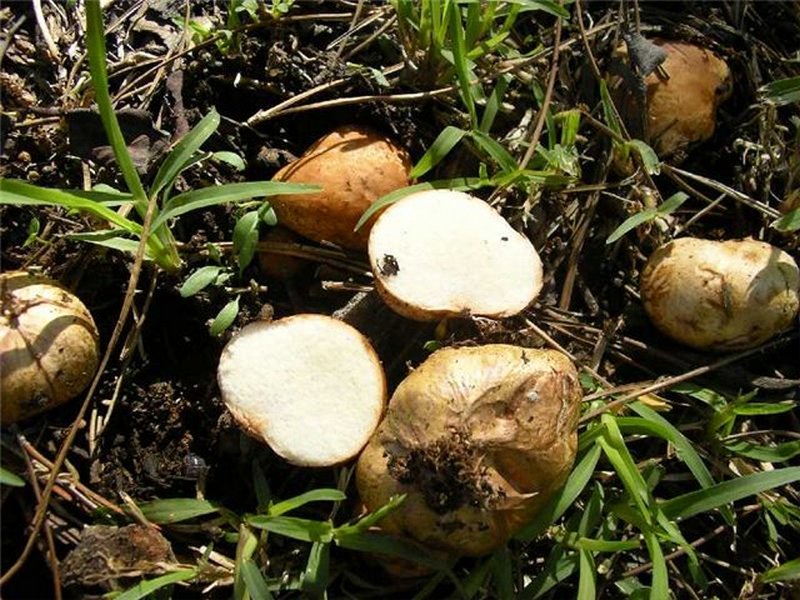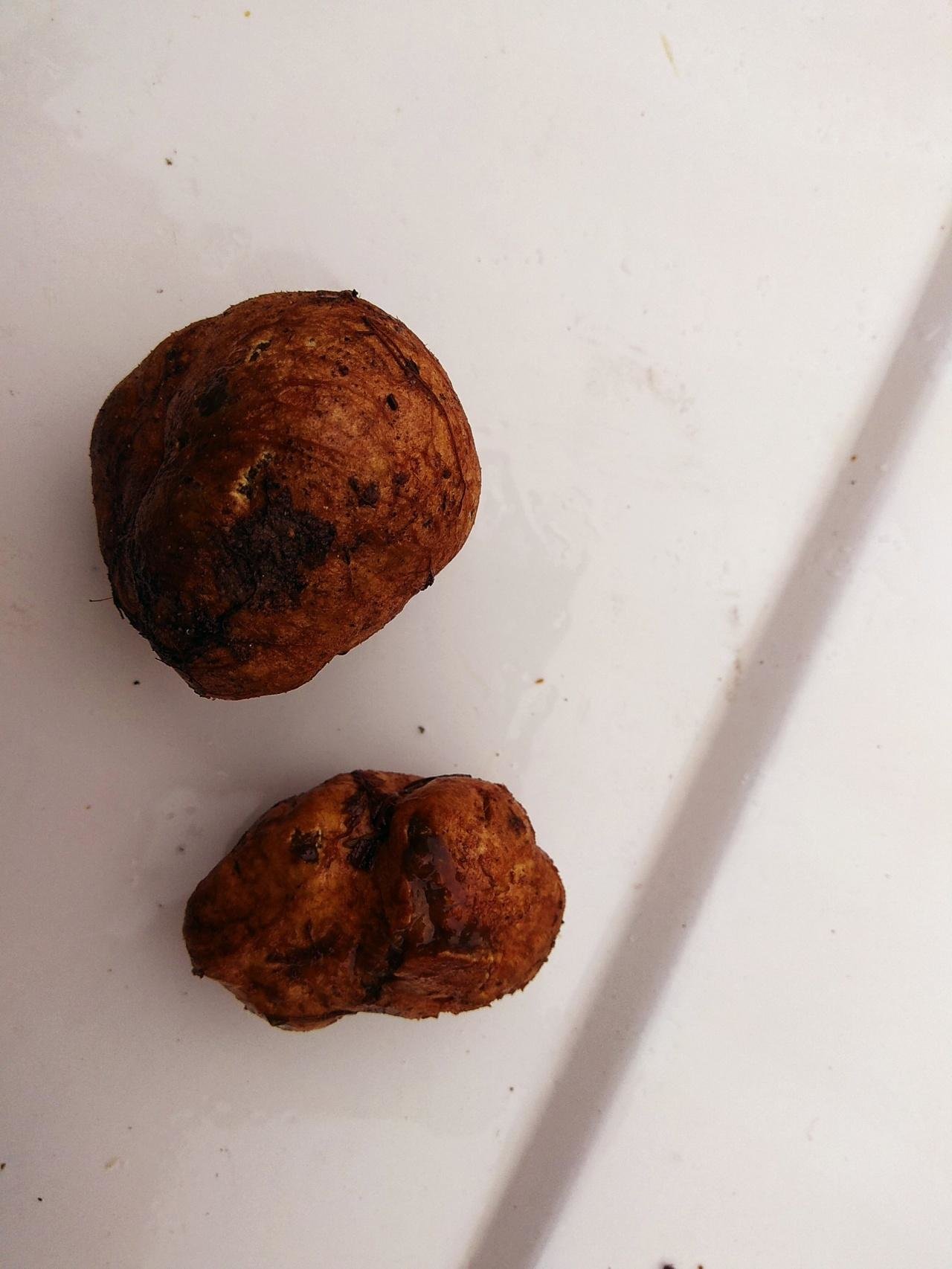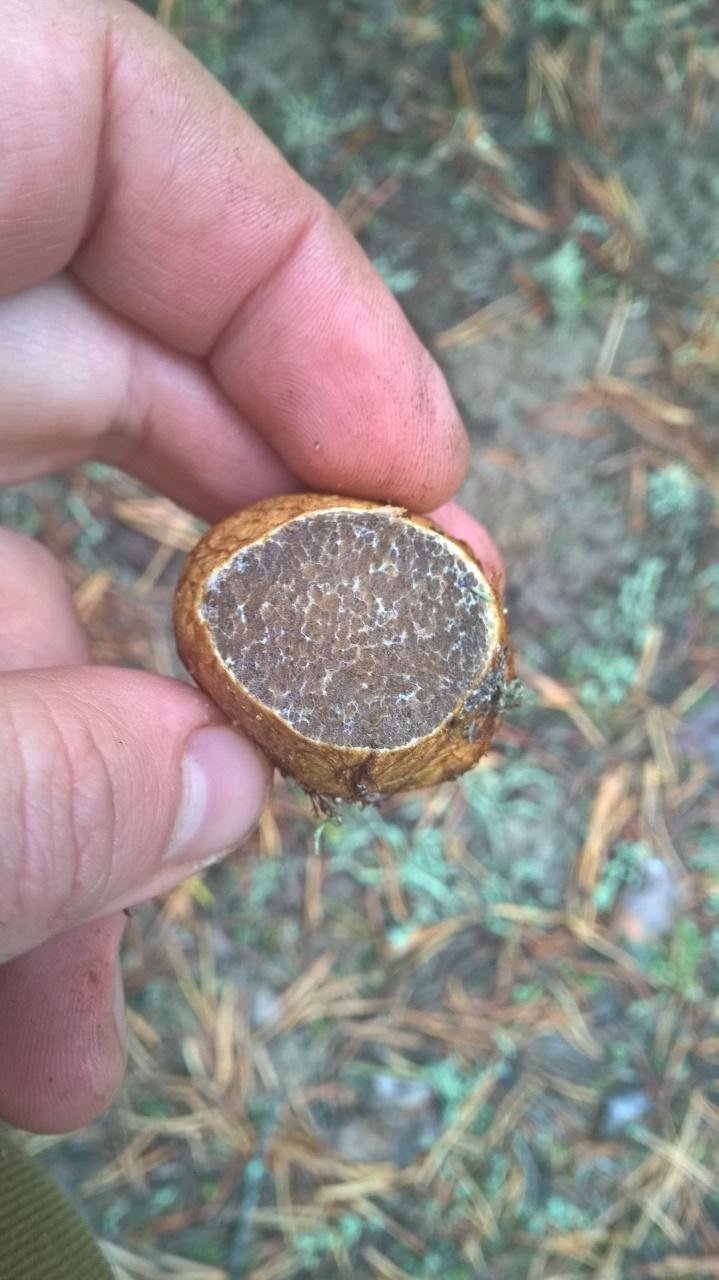Rizopogon yellowish: what it looks like, where it grows, photo, is it possible to eat
Rhizopogon yellowish - a rare saprophyte mushroom, a relative of raincoats. Belongs to the class Agaricomycetes, family Rizopogonovye, genus Rizopogon. Another name for the mushroom is yellowish root, in Latin - Rhizopogon luteolus.
Where do yellowish rhizopogons grow
Rhizopogon luteolus is found throughout the temperate and northern latitudes of Eurasia. Grows in small groups mainly in pine forests on sandy and sub-sandy soils.
Forms mycorrhiza with conifers, most often with pines. It can be found in wooded summer cottages and parks. Loves loose soils with a high nitrogen content.
The fruiting body of the fungus is almost completely hidden underground or under a layer of fallen leaves, so it is not easy to find it.
What do yellowish rhizopogons look like?
Rhizopogon luteolus has a rather strange appearance for a fungus. He is missing a hat and a leg. The division of the fruiting body into upper and lower parts is rather arbitrary. Outwardly, it resembles a tuber of young potatoes. Has a size from 1 to 5 cm.
Young specimens are whitish-olive or light brown, mature ones are brown or brown. The surface of the fruiting body is dry. As it grows, its skin gradually cracks. The fruit body is entangled with gray-black filaments of the mycelium. Mature specimens have a pronounced garlic smell.
Spores are ellipsoidal, slightly asymmetric, shiny, smooth, transparent. The size of the spores is approximately 8 x 3 µm.
Taste qualities of the mushroom yellowish rhizopogon
Rhizopogon luteolus has a low taste. Despite the fact that it is considered edible.
Fried Rhizopogon tastes like a raincoat.
Benefits and harm to the body
Rhizopogon luteolus belongs to the fourth flavor category. The composition contains nutrients, but if used and prepared incorrectly, it is dangerous and can harm the body.
False doubles
Rhizopogon yellowish is similar in appearance to its relative - pinkish rhizopogon (Rhizopogon roseolus), another name for which is a blushing truffle or a turning pink truffle. This mushroom has a yellowish skin, if broken or cut, the flesh turns pink in this place.
The fruit body of a pinking truffle has a tuberous or irregularly rounded shape. Most of it is underground. The wall of the fruiting body is whitish or yellowish; when pressed, it becomes pinkish.
Rhizopogon pinkish edible, suitable for consumption only at a young age.
It is partially or completely hidden in the ground. The skin of a young mushroom is velvety; in a mature one, it becomes smooth and slightly cracks. Grows in spruce and pine forests, sometimes found in deciduous.
The harvesting season is from June to October. Never grows alone.
Rizopogon yellowish resembles dubious melanogaster (Melanogaster ambiguus). It is a very rare edible mushroom that grows singly in deciduous forests from May to October.
The pulp of the mushroom is purple-black, thick, fleshy, with a slight smell of garlic. Taste quality is low.
Collection rules
The harvesting season is from July to September. Rhizopogon luteolus is best harvested at the end of the season when it produces the highest yields.
Use
For eating, it is necessary to choose young specimens with a pleasant creamy pulp (old dark mushrooms cannot be used).
First, they must be rinsed under running water, carefully scrubbing each copy to remove the garlic taste and smell, then peel the thin skin.
Rhizopogon luteolus is prepared in the same way as raincoats, which are their closest relatives.All types of culinary processing are suitable for cooking - boiling, frying, stewing, baking, but they are most delicious when fried.
Attention! The mushroom can be dried, but only at a high temperature, otherwise it will germinate. Rhizopogon yellowish - a little-known species even among mushroom pickers
It is easy to confuse it with a white truffle, which is used by scammers selling it at a high price.
Rhizopogon yellowish - a little-known species even among mushroom pickers. It is easy to confuse it with a white truffle, which is used by scammers selling it at a high price.
False doubles
In appearance, common Rhizopogon is similar to the very rare Melanogaster ambiguus, a gasteromycete of the Pig family. Its fruiting body is represented not by a cap and a leg, but by an integral gastrocarp with a dense shell and a fruiting gleba. The surface of the mushroom is at first dull and velvety, colored in a gray-brown scale. As it matures, the peridium takes on a yellow-olive color with dark brown spots that resemble bruises. Old mushrooms are black-brown with a whitish coating.
Inside, the young melanogaster is whitish with blue-black chambers; in adulthood, the flesh darkens significantly, becoming red-brown or black with whitish veins. At the beginning of growth, the mushroom exudes a pleasant sweetish fruity aroma, but over time it is replaced by the fetid smell of dying onions or rubber. Information about the possibility of use is contradictory: some experts consider the mushroom edible at a young age, while others refer to the inedible species.
It is not surprising that common Rhizopogon is similar to other fungi of the genus Rhizopogon, in particular, yellowish Rhizopogon (Rhizopogon luteolus). The fungus is widespread in the temperate zone and in the north of Eurasia; it prefers light sandy soils of pine forests.
The surface of the fruit body at a young age is painted in a whitish-olive or light brown color, later darkens to brown-brown and cracks. The skin is entangled with brown-gray filaments of mycelium. The pulp is initially yellowish-white, with age it changes color to yellow-olive or greenish-brown. Old mushrooms are almost black inside. Rhizopogon yellowish is considered a conditionally edible product with low taste, when fried it looks like a raincoat.
Another double of the common rhizopogon is the pinkish rhizopogon (Rhizopogon roseolus), also called the pinkish or reddening truffle. The species is distinguished by a yellowish skin, which, when pressed, turns pink, like the flesh when cut or broken. The places and season of growth of the pinking truffle are identical to the common rhizopogon. The species is conditionally edible.
According to external data, common rhizopogon can be confused with an edible white truffle. The valuable counterpart also has a brownish color and tuberous shape, but it is more sinuous and coarse.
Rizopogon

Rhizopogon pinkish can be found only occasionally, since this mushroom tends to develop half underground. The fruiting body is up to 1-4 cm in diameter, irregularly spherical or tuberous, at an early age whitish, velvety, after naked and yellowish, in the air and upon damage acquire a reddish-pink or red-brownish color, hard, with whitish "roots" (rhizomorphs) below. The inside is yellow-olive, oily yellow, or light greenish, with thin, small, curved chambers. The pulp has a fruity smell. Spores are smooth, light lemon-yellow, elliptical, 8.4-11 x 3.60-4.5 microns.
In summer it occurs quite often and in autumn during the period (June - October) mainly in mixed and deciduous and coniferous forests, most often under spruces and pines, but also under oaks and other trees.
The mushroom is edible.
Rhizopogon pinkish is very similar to the common rhizopogon (Rhizopogon vulgaris), which is distinguished by a gray-brown color of non-reddening fruit bodies
RIZOPOGON YELLOW, YELLOW ROOT RHIZOPOGON OBTECTUS

Rhizopogon is a yellowish, yellowish rootstock of Rhizopogon obtectus (Rhizopogonluteolus).
Fruit body: yellowish tuberous rhizopogon, oblong, about the size of a walnut, part of the fruit body goes into the ground, the outer layer is cork-hard, brown-leathery closer to youth, dirty brown in old age, entwined with thin brown hyphae from the lower part. The outer layer has a fine sinuous pattern and a garlic smell
Season and place: Yellowish Rhizopogon grows in autumn and summer in pine forests on sandy soil. Very often only the top can be seen from the ground.
Similarity: The mushroom is tasteless. Try not to confuse this mushroom with poisonous species.
Red trellis mushroom
The red trellis mushroom, or, as it is also called, the red clathrus, is listed in the Red Book and is the only representative of the trellis family. Found in Russia mainly in ...
Mushroom netnose. In young mushrooms, the fruit body is ovoid, sometimes cylindrical. white or yellowish white colors with a diameter of up to five centimeters. When the fruit body of the fungus is set ...
The largest living organism on Earth is the mycelium
Finally, nothing living can match the size of mushrooms. In the US state of Oregon, there is a dark mushroom that extends over 10 square kilometers. Its age is from 1900 to 8650 years. However, despite its truly gigantic size, the mushroom was discovered only in the 21st century.
We see the mushrooms themselves only when the time for reproduction comes. If mushrooms were not sexually active, we might not even be aware of their existence.
Scientists were able to find out that mycelium mushrooms can reach such gigantic proportions only with the advent of DNA sequencing technology. After analyzing DNA samples from mushrooms in the area, scientists realized that all mushrooms are genetically identical.
Using the same method, researchers began to study colonies of microscopic fungi that live in soil and water, in plants and animals, and even in the air itself. The speed with which specialists are discovering all new types of fungi made them estimate the total number of these species on Earth at more than five million.
What other incredible feats are mushrooms that are not yet known to us?Systematics:
- Department: Basidiomycota (Basidiomycetes)
- Subdivision: Agaricomycotina
- Class: Agaricomycetes (Agaricomycetes)
- Subclass: Agaricomycetidae
- Order: Boletales
- Family: Rhizopogonaceae (Rhizopogonaceae)
- Genus: Rhizopogon
- View: Rhizopogon vulgaris (Rhizopogon common)
Other names for the mushroom:
Other names:
External description
The fruiting bodies of Rhizopogon vulgaris are tuberous or round (irregular) in shape. at the same time, only single strands of fungal mycelium can be seen on the surface of the soil, while the main part of the fruiting body develops underground. The diameter of the described fungus ranges from 1 to 5 cm. The surface of the common rhizopogon is characterized by a grayish-brown color. In ripe, old mushrooms, the color of the fruiting body may change, becoming olive-brown, with a yellowish tinge. In young mushrooms of common rhizopogon, the surface is velvety to the touch, and in old ones it becomes smooth. The inside of the mushroom is dense, oily and thick. At first, it has a light shade, but when mushroom spores mature, it becomes yellowish, sometimes brown-green.
The pulp of Rhizopogon vulgaris does not have any specific aroma and taste; it consists of a large number of special narrow chambers in which the spores of the fungus are located and mature. The lower region of the fruiting body contains small roots called rhizomorphs. They are white.
The spores of the fungus Rhizopogon vulgaris are characterized by an elliptical shape and a fusiform structure, smooth, with a yellowish tinge. A drop of oil can be seen along the edges of the spores.
Season and habitat of the mushroom
Common Rhizopogon (Rhizopogon vulgaris) is widespread in spruce, pine-oak and pine forests.You can also find this mushroom sometimes in deciduous or mixed forests. It grows mainly under conifers, pines and spruces. However, sometimes this type of mushroom can also be found under trees of other species (including deciduous ones). For its growth, Rhizopogon usually chooses soil or litter from fallen leaves. It is not found too often, it grows on the surface of the soil, but more often it is deeply buried inside it. Active fruiting and an increase in the yield of ordinary rhizopogon occurs during the period from June to October. It is almost impossible to see solitary mushrooms of this species, since Rhizopogon vulgaris grows only in small groups.
Edibility
Rhizopogon ordinary belongs to the poorly studied mushrooms, but it is considered edible. Mycologists recommend eating only the young fruiting bodies of Rhizopogon vulgaris.
Similar types and differences from them
Common Rhizopogon (Rhizopogon vulgaris) is very similar in appearance to another mushroom of the same genus, which bears the name. True, in the latter, with damage and strong pressure, the pulp turns red, and the color of the outer surface of the fruiting body is white (in mature mushrooms it becomes olive-brown or yellowish).
Interesting Facts
A large colony of rhizopogons caused a "sensation" - it was announced that large quantities of white truffles were found in Siberia. Even the mycologists were at first delusional, but subsequent analysis of the dispute pointed to the delusion.
dug, on a stump
Edible underground mushrooms didn't always live underground. They are similar to whales and dolphins, whose ancestors were marine animals, then went on land, becoming land, but returned to the ancient native element, again turning into aquatic inhabitants. The distant ancestors of today's underground mushrooms formed fruiting bodies on the soil surface, but in order to increase their protection they again hid them underground. They made a choice between the ease of spreading spores and the degree of their preservation in favor of preservation.
There are not so many mushrooms with underground fruiting bodies. Most of them are marsupial mushrooms (relatives of morels and lines), they are small in size and practically tasteless (before, by the way, they were used as aphrodisiacs); there are also quite a few underground raincoats, which are just as culinary nondescript. The only exception to the marsupials is the famous truffles, which are great in taste and quite large. As for the cap mushrooms that have returned underground, there are only a few of them in our area. These are four types of so-called rhizomes, an underground russula, known as the underground russula Mattirolo (Elasmomyces mattirolianus), and a tiny spherical underground varnish. Kornevtsy resemble most of all a small rounded potato, the Mattirolo russula looks like a russula, the edges of the cap of which are attached to the leg. Both root roots and underground russula taste rather mediocre.
Kornevtsy are distant relatives of the porcini mushroom. They belong to the Rhizopogonaceae family of the order Boletales. Mycorrhizal forest mushrooms, 4 species are known on the territory of Russia, of which the most common rootstocks are yellowish and pinkish.
The other day, being at a dacha in Zagoryanka (the village of Zagoryansky, near Moscow), my eldest daughter made me happy with a rather rare find. In the “forest” part of the site, she dug up a large, luxurious specimen of pinkish rootstock.
According to her, she just "lay in the leaves, and the mushroom itself climbed into the hand." I wish all the exotics would continue to do so.
NormalfalsefalsefalseRUJAX-NONE
How the rootstock was searched.
There was a real giant, seven centimeters in diameter, almost a champion in size. Usually, fruiting bodies are 1-6 (up to  cm in diameter. They are tuberous, irregularly rounded.
cm in diameter. They are tuberous, irregularly rounded.
The outer surface is thin, white, later yellowish or olive-brown, reddening when touched, with single dark mycelial strands on the surface.
The inner spore-bearing part is fleshy, dense, white, turning pink at the cut, later (when ripe) yellowish, brownish-greenish, without any special taste or smell, with numerous narrow winding chambers filled with spores.
Spores 8-12x3.5-4.5 microns, fusiform-ellipsoid, yellowish, smooth, with two drops of oil.
Spore powder lemon yellow.
A "nest" of pinkish roots in a pine forest.
The fungus is quite rare, grows shallowly in the soil or on the soil surface in pine forests (forms mycorrhiza with two-spined pines), parks, wooded summer cottages, often in "nests" of 2-8 specimens, in July-November. Prefers loose, sandy, well-drained and at the same time well-moistened soils with a sufficient amount of humus.
this is how he is on the one hand, this is how he is on the other hand, this is how he is on the cut
Cookie Policy Mikhail Vishnevsky, 2012-2019 Log out | Edit
Common Rhizopogon (Rhizopogon vulgaris) is a rare member of the Rizopogon family. It is often confused with white truffle, which is actively used by scammers who sell risopogones at a high price.
In another way, the view is called:
- common truffle;
- regular truffle;
- Rhizopogon is common.
Rhizopogon yellowish, Rhizopogon obtectus
Fruit body: Gasteroid, tuberous, small - up to 5 cm in greatest dimension, fully or partially buried in the soil. On the lower (relatively speaking) part of the fungus there are pronounced gray “roots” - rhizomorphs, which gave the name to the whole genus. Color - from yellowish-tobacco to brown, irregular coloration, varies greatly depending on the age of the fungus and growing conditions. The surface is usually dry, cracks and flakes with age. The pulp is finely porous, dense; as the spores mature, it changes color from yellowish to olive and almost black. The skin is thin, with a scent reminiscent of garlic.
Spore powder: Light yellow (or white?).
Spreading: Rhizopogon yellowish is found in places often and abundantly in pine forests, on poor sandy soil. It is difficult to assess the abundance, because most of the harvest is hidden from the human eye. This amazing mushroom bears fruit from mid-summer to late September.
Similar species: Rhizopogon obtectus resembles the less common (or more carefully hidden underground) pinkish rhizopogon, Rhizopogon roseolus. Its distinctive features are clear from the name - the pinkish rhizopogon has the corresponding color of the outer cover, and it turns noticeably pink on the cut. It is curious that according to many reports, yellowish rhizopogon can be sold as a white truffle (Choiromyces meandriformis), taking advantage of the fact that the general public is rather poorly familiar with these mushrooms.
Edibility: Summarizing data from various sources, it can be concluded that the mushroom is practically inedible, although young rhizopogons with white flesh, some lovers fry and eat.
Author's notes: Underground mushrooms of a person are alarming: either they represent a contradiction of the very idea of a fungus as a spore producer (why are spores under the ground where mycelium is full?), Or we do not quite understand this idea correctly. How could evolution have tolerated this? Hard to say. Only if we assume that rhizopogons, like real truffles, attract the inhabitants of the forest with an appetizing smell, and they tear the ground in search of a delicacy, and then carry the good news to the distant edge of the forest. but even then it does not add up. Both the rough boar's snout and the delicate squirrel legs will turn any mycorrhiza into rags. What is the point of paying so dearly for such a mundane task as removing a dispute? What's the point in underground mushrooms.

It should be noted that the "sponginess" of this rhizopogon is very imaginary: in terms of meat density, it is hardly inferior to any scleroderma. In turn, by the color of the cut, one can easily conclude that the youth of this mushroom, despite its modest size, is already behind.
Use
For eating, it is necessary to choose young specimens with a pleasant creamy pulp (old dark mushrooms cannot be used).
First, they must be rinsed under running water, carefully rubbing each copy to remove the garlic taste and smell, then peel the thin skin.
Rhizopogon luteolus is prepared in the same way as raincoats, which are their closest relatives. All types of culinary processing are suitable for cooking - boiling, frying, stewing, baking, but they are most delicious when fried.
Attention! The mushroom can be dried, but only at a high temperature, otherwise it will germinate
Mushrooms spawn zombies
The wind is something else. Some mushrooms can create a real walking nightmare.
Fungi of the species Ophiocodyceps, which live in tropical forests, inhabit the brains of carpenter ants. The Thai mushroom Ophiocordyceps unilateralis causes the ant to move erratically, causing the insect to fall from the foliage to the ground. After that, the mushroom tells the ant to climb the tree trunk to a height of a little less than a meter - that is, where conditions are ideal for the growth of the fungus in terms of temperature and humidity.
He controls not only the height to which the ant rises, but also the direction - usually it is north-north-west. Usually, ants do not chew leaves from a tree, but insects infected with fungi begin to gnaw them. And zombie ants begin to eat leaves at exactly noon - a fact worthy of science fiction.
In this unusual position, the ant dies. In rigor mortis, the insect's jaws continue to grip the leaf, as the ant's muscles atrophy due to the fungus growing through its head. The body remains in this position for up to two weeks. The mushroom, meanwhile, prepares to breed. Finally, he showered his spores on healthy ants, which, without suspecting anything, continue to get food in order to carry it to their nests in the tree crown.
The cycle of zombification repeats itself.
This type of mushroom has honed its zombification skills to the highest level. It inspired filmmakers and video games, and launched a crowdfunding campaign to find the genes responsible for controlling the ant.
Who doesn't love zombie stories?
Mushrooms are faster than bullets
When it comes to the speed of bringing offspring out of the house, mushrooms are second to none among living organisms.
Spores of the dung fungus Pilobolus crystallinus fly faster than bullets and any living organisms on our planet.
In appearance, Pilobolus does not look like an ordinary mushroom. It resembles a tiny transparent snake with a bowler hat on its head. This hat is a bag of spores, and the mushroom can shoot it, and the maximum speed of the bag of spores can reach 25 meters per second, and the acceleration is 1.7 million meters per second squared. For comparison, the American rocket "Saturn-5", which was used to launch the second lunar mission "Apollo-8", accelerated no faster than 40 meters per second squared.
Image copyright Jason Hollinger CC by 2.0 Image caption This mushroom has 28,000 gender variants
It is not surprising that in the English-speaking world this mushroom is called the "hat-launcher".
If you want to compare this dung cannon to a firearm, here's a great storyline from Earth Unplugged.
Spoiler alert: Yes, Pilobolus spores fly faster than bullets and shot.
Where pinkish rhizopogons grow
The mushroom rhizopogon is found under spruce and pine, in mixed forests, where oak predominates, less often under other deciduous species. It is located in groups shallow in the soil, covered with leaf or coniferous litter. Only a small part of mature specimens appears on the surface, and even then rarely. The mode of growth makes it difficult to harvest and determine the boundaries of the distribution of the population. Fruiting is long; harvesting begins in the middle of summer. In the middle lane, if autumn is warm with sufficient rainfall, the last specimens are found in mid-October.The main accumulation of reddening truffles is sought near pines and firs under a coniferous pillow.
Similar species
First of all, pinkish Rhizopogon is very similar to its own “brother” - Rhizopogon ordinary (yellowish). The differences between them consist only in the color of the pulp (in the ordinary species, it does not turn red and is colored brown or yellow). In terms of nutritional quality, both mushrooms are identical.
Sometimes pink rhizopogon is also called “the truffle of fools” because of the external similarity with a delicacy truffle, for example, African truffle. The use of truffles in Russia is rather exotic, and therefore the concept of how this expensive mushroom looks like in reality is rather approximate for many. This is what scammers often use, passing off a rather mediocre mushroom for an expensive delicacy and profiting well from it.

1- Rizopogon ordinary 2- African truffle
Pinkish rhizopogon has no poisonous analogues.
Mushrooms gave man alcohol
It is impossible to write an ode to mushrooms without starting with alcohol.
One of the groups of fungi - yeast - generates energy during fermentation, the by-products of which are carbon dioxide and alcohol.
For most microorganisms, alcohol is a poison, but yeast has managed to develop a tolerance for high degrees in the process of evolution.
Mankind learned to appreciate the nutrient-rich and bacteria-free drinks about 10 thousand years ago, long before the invention of pasteurization and refrigerators. Some scientists, in particular biomolecular archaeologist Patrick McGovern, even believe that our ancestors began to grow and store crops not because they needed more bread, but for the sake of alcohol.
McGovern is the Science Director of the Biomolecular Archeology Project on Culinary, Fermented Drinks, and Public Health at the University of Pennsylvania Museum in the United States. He found that an obsessive interest in alcohol appeared in a person much earlier than is commonly believed. The scientist sequenced the DNA of yeast from ancient Egyptian wine vessels, which are more than 5 thousand years old (this yeast turned out to be the ancestors of the modern fermentation yeast Saccharomyces cerevisiae). In China, McGovern found evidence that people produced alcohol even earlier - more than 9 thousand years ago, that is, long before the invention of the wheel. These were the priorities.
Season and habitat of the mushroom
Common Rhizopogon (Rhizopogon vulgaris) is widespread in spruce, pine-oak and pine forests. You can also find this mushroom sometimes in deciduous or mixed forests. It grows mainly under conifers, pines and spruces. However, sometimes this type of mushroom can also be found under trees of other species (including deciduous ones).
For its growth, Rhizopogon usually chooses soil or litter from fallen leaves. It is not found too often, it grows on the surface of the soil, but more often it is deeply buried inside it. Active fruiting and an increase in the yield of ordinary rhizopogon occurs during the period from June to October. It is almost impossible to see solitary mushrooms of this species, since Rhizopogon vulgaris grows only in small groups.
Mushroom wind
In addition to producing insane amounts of yeast, mushrooms can also induce wind.
In a way, a mushroom is like a fruit hanging from a tree. The cap of a mushroom is full of spores, like a fruit is full of seeds. However, unlike a tree, most of the fungus is hidden underground. The mycelium forms a network that connects the mushrooms on the surface.
Image copyright Thinkstock Image caption Mold is also a mushroom
Fungi need their spores to fly as far as possible; then the offspring will not compete with their "parents" for nutritional resources. At the same time, mushrooms cannot count on the help of animals in traveling long distances. They have to rely on themselves and use the available resources. The main one is water.
When it comes time to spray the spores, the mushrooms release water vapor, thus cooling the air around them. The air currents create a lift that can carry spores up to 10 centimeters in all directions.
Conclusion
Common Rhizopogon is a strange and unusual mushroom with the appearance of a potato and the taste of a raincoat. Having found it in the forest, there is no need to rush, it is worth carefully examining the soil around, because others probably lurked nearby.

